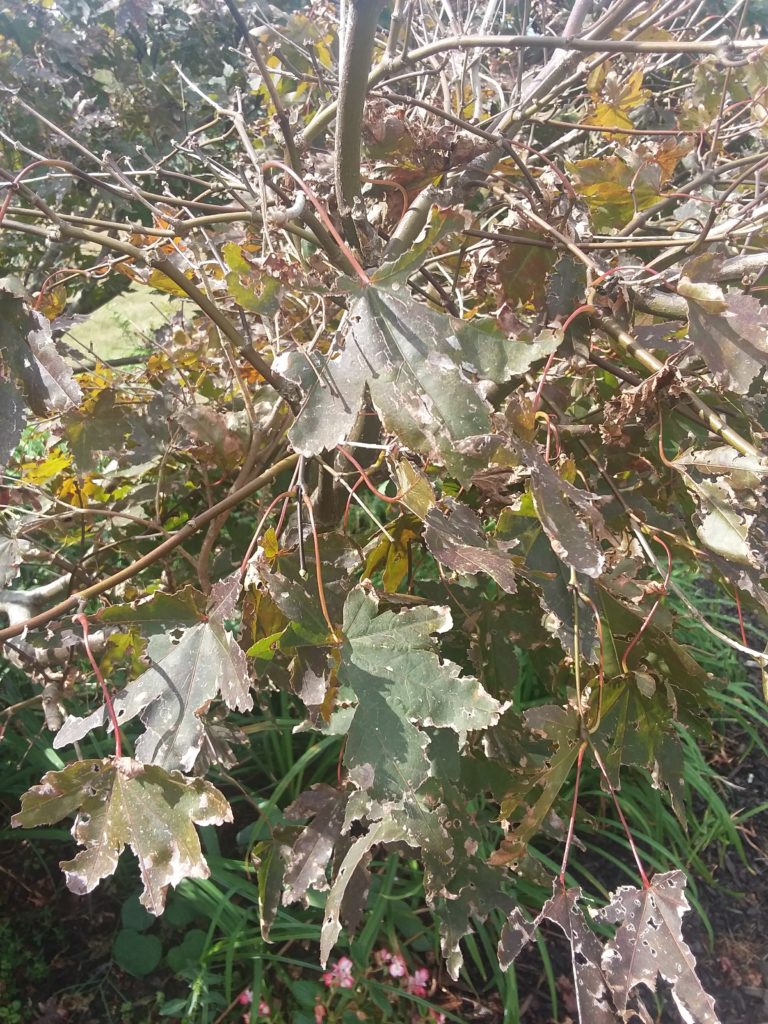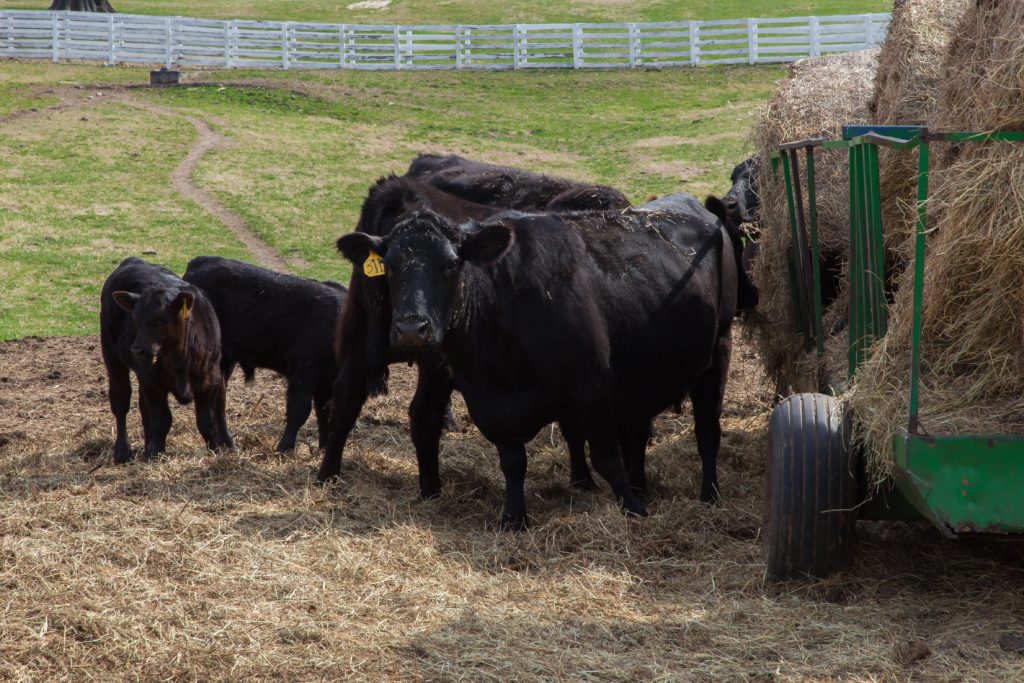Hay, Snake Stink, and Maple Tree Q&A
go.ncsu.edu/readext?629183
en Español / em Português
El inglés es el idioma de control de esta página. En la medida en que haya algún conflicto entre la traducción al inglés y la traducción, el inglés prevalece.
Al hacer clic en el enlace de traducción se activa un servicio de traducción gratuito para convertir la página al español. Al igual que con cualquier traducción por Internet, la conversión no es sensible al contexto y puede que no traduzca el texto en su significado original. NC State Extension no garantiza la exactitud del texto traducido. Por favor, tenga en cuenta que algunas aplicaciones y/o servicios pueden no funcionar como se espera cuando se traducen.
Português
Inglês é o idioma de controle desta página. Na medida que haja algum conflito entre o texto original em Inglês e a tradução, o Inglês prevalece.
Ao clicar no link de tradução, um serviço gratuito de tradução será ativado para converter a página para o Português. Como em qualquer tradução pela internet, a conversão não é sensivel ao contexto e pode não ocorrer a tradução para o significado orginal. O serviço de Extensão da Carolina do Norte (NC State Extension) não garante a exatidão do texto traduzido. Por favor, observe que algumas funções ou serviços podem não funcionar como esperado após a tradução.
English
English is the controlling language of this page. To the extent there is any conflict between the English text and the translation, English controls.
Clicking on the translation link activates a free translation service to convert the page to Spanish. As with any Internet translation, the conversion is not context-sensitive and may not translate the text to its original meaning. NC State Extension does not guarantee the accuracy of the translated text. Please note that some applications and/or services may not function as expected when translated.
Collapse ▲If you were excited by the rain this week, then you are certainly a farmer or gardener at heart. I found it just a little easier to be in a “good mood” with some refreshing rain.
This week I would like to share questions that were asked at the N.C. Cooperative Extension, Caldwell County Center. I hope you find these questions and answers helpful. If you have specific questions not answered here, please contact me and my team at the office.
Question: How do I estimate how much hay I need for the winter? I have cattle, a horse, and two goats.
Answer: For grazing animals, I use body weight to determine how much feed is needed on a daily basis. A lactating beef cow consumes about 3% of her body weight per day of hay and feed. The 3% figure assumes a small percentage of what is offered will be wasted (not consumed by the animal). For example, a small 1,100 pound cow will consume about 33 lbs of hay per day, and a larger 1,300 pound cow needs about 40 lbs of hay daily. Knowing how much your cows weigh is one factor you really need to know to calculate an accurate feed budget. And there are even larger animals in the county. It is not uncommon to have 1,600 and even 1,800 pound animals. These big girls will consume over 50 pounds of hay and feed per day!
Dry cows consume less feed. Dry cows are animals that are not making milk for their calves. They don’t eat as much as lactating cows, and they don’t need as high a quality of diet either. I use 2.5% of their body weight to calculate daily intake. Sheep and goats consume 4% of their body weight, and horses consume about 2.5% of body weight for maintenance. However, horses vary their consumption based on feed quality and activity level.
To calculate the hay and feed needed, multiply the daily feed intake by the length of time the animals will be fed. Hay feeding ranges from 150 days per year on the high side to 60 days on the low side. I think 100 – 120 days is probably average for Caldwell County livestock owners.
To work an example, let’s assume we have 10 cows that weigh about 1,300 pounds and 3 cows that weigh 1,600 pounds. The animals all have calves that were born this fall so they are all lactating. We will plan to feed hay 120 days this winter. We assume the 10 cows will consume 40 pounds of hay per day, or 400 pounds for all 10. The 3 big 1,600 pound girls will each eat 50 pounds of hay per day, or 150 total. So each day, the herd will consume 550 pounds per day. For the entire 120 day period, they will consume 66,000 pounds of hay and feed.
These numbers assume the hay meets the needs of the animals. Rarely will fescue hay meet the needs of lactating beef animals. Supplemental feed is typically needed to meet the energy and protein needs of the lactating animals. Monitoring body condition of the animals lets you know if your feeding program is meeting the needs of the animals. For example, if the animals are losing condition (weight), then the feeding program is not covering the needs of the animals, and the feeding program should be modified.
Stored hay can be analyzed for nutritional quality. This information will determine if supplementation is needed to meet the nutritional needs of the animals. Also, the hay bales should be weighed. Typically, bales weigh much less than producers estimate their weight to be.
If you need help developing a winter feeding budget, please contact the N.C. Cooperative Extension, Caldwell County Center and I will help.
Question: Is this snake stink (If you know what I mean)? What is this?

These creepy masses can pop up over night. However, they are not snake droppings or dog deposits. This is actually a fungus-like organism that feeds on organic matter. (credit Toni Anderson)
Answer: I received this question via text message along with the picture. Although it might look like something excreted from a snake or retched from a dog, it is actually a slime mold.
The recent rains have produced conditions that allow these peculiar “slimy” or “crusty” masses to appear seemingly overnight in mulched areas. Although these creepy masses are considered to be a fungus-like organism, they possess animal-like characteristics which make them interesting to watch and examine. Slime molds are saprophytic; that is, they feed on decaying organic materials, bacteria, and yeasts. These curiosities are not considered plant disease organisms.
Slime molds produce spores that are wind-borne. These spores are very resistant to unfavorable environmental conditions. Spores can remain viable for years. As the spores absorb moisture, they crack open to release a swarm spore (zoospore) that can swim in a water film. These structures produce an amoeba-like body (plasmodium) that can move very slowly. As the slime mold body matures, it changes from a slimy, wet consistency to a crusty mass.
Since slime molds are considered a nuisance, no chemical control is recommended. The best way to react to these curiosities is to break them up and dry them out. They can be flipped over in the mulch with a pitchfork. Or use a garden hose to wash the powdery spore masses back into the mulch.
Question: What do I need to do? My maple tree looks horrible.

Maples leaves are susceptible to all kinds of leaf diseases. Although they may look unsightly, they rarely cause a problem for the over all health of the tree. (credit Bill and Judy)
Answer: Maple tree leaves are “famous” for getting every fungus out there. Fungi overwinter in fallen leaves. The most effective management technique is to rake and destroy leaves in the fall. This will reduce the number of overwintering fungi that can infect new leaves the following spring. Ideally, your neighbors should also rake and destroy infected leaves to be effective. Composting leaves is an effective way to destroy many of the disease fungi for next year.
Applications of fungicides are technically possible, but control of leaf spot is challenging, especially on mature maples. In nearly all situations, making a fungicide application is not practical. Also, sprays will not cure infected leaves. Therefore, once the damage is noticed, spraying has limited value. Making a fungicide application would need to be started as buds break in the spring and repeated at 10–14-day intervals or as recommended by the label.
Selecting plants for the landscape that are able to thrive is the best long term solution. And those that do not perform well should be removed rather than allowed to be an eye-sore.
Thanks to Dr. Stephen Vann assistant professor and Extension urban plant pathologist at the University of Arkansas for his assistance with slime molds. And a big thank you to Allen Caldwell, NC State Extension Agent Emeritus for his assistance with leaf spots and maple fungi.
For answers to your agriculture questions, call the N.C. Cooperative Extension, Caldwell County Center at 828-757-1290 or visit us online anytime.





